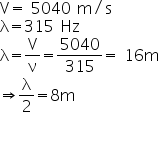Test: Characteristics Of Sound Waves - Class 9 MCQ
20 Questions MCQ Test Physics for Class 9 - Test: Characteristics Of Sound Waves
Which of the following correctly relates the wavelength λ, frequency f and velocity v of sound?
The wavelength of the sound produced by a tuning fork of frequency 450 Hz which is set to vibrate in the air (take the velocity of sound in air as 320 m/s) is
A siren has 16 holes and is making 960 revolutions per minute. The frequency of the sound produced by the siren is:
Arrange in increasing order – Speed of sound in steel, in distilled water, in sea water and in oxygen.
A top makes 16 rotations about its own axis within 0.4 seconds, its frequency is:
On which quantity does the pitch of the sound depend?
What is the difference between a low pitched and high pitched sound?
Sound from a flute and sound from a harmonica played by passing air through musical instrument, at same time and same distance from ear and traveling through same medium air, they differ in sounds due to difference in
A stationary rail engine produces whistle with a frequency 2600 Hz. A person standing at a distance of 550 m from engine will listen ___________ no. of waves within one minute.
If we increase the temperature of air from 0°C to 22°C, then the speed of sound would
By counting the number of vibrations of a tuning fork per second, __________ can be found.
A bell vibrates 600 times within 3/2 seconds, its frequency and time period will be:
A swing has a time period of 1.4 seconds. The no. of oscillations made by it within 1 minute 24 seconds will be:
Choose one of the following, on which the frequency of a vibrating body does not depend.
A baby cries with a frequency 712 Hz, if the speed of sound in air is 356m/s, the wavelength of sound is:
A progressive transverse wave has a speed of 5040 m/s, its frequency is 315 Hz, then the distance between a crest and an immediate trough is:
|
16 videos|69 docs|56 tests
|























